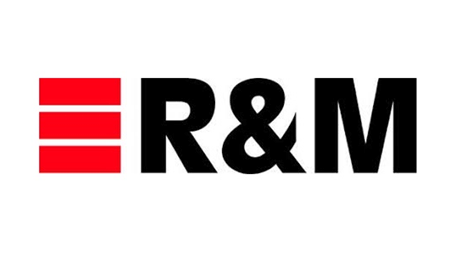R&M – Fiber Optic Cabling in Demand in 2023 Like Never Before
 R&M is expecting more investments in fiber optic infrastructures in all market segments.
R&M is expecting more investments in fiber optic infrastructures in all market segments.
The trend toward network convergence is paving the way for the future.

Fiber optic cabling will remain in demand like never before. This is what R&M, the globally active Swiss developer and provider of high-quality infrastructure solutions for data and communications networks, is expecting. Looking ahead to 2023, R&M CMO Andreas Rüsseler quotes current market studies that confirm R&M’s trend observations. Andreas Rüsseler reports on forecasts, technology, and market developments in his blog series.
Fiber optic demand is not only growing in the market of data center providers who are upgrading their networks, interconnects, and backbones. Broadband supply is also seeing intensive expansion. In addition to Fiber to the Home (FTTH), an additional growth market is emerging with Fiber to the Antenna (FTTA).
Convergence for hybrid data centers
“The demand for efficient infrastructures is driving the trend towards convergent hybrid network solutions,” says R&M’s CMO.
Countless new applications require real-time data processing close to the action. Hybrid data centers can do this by combining physical, virtual, and cloud infrastructures to create network-based data centers. For complete convergence, however, powerful FO-based access and backbone networks must be available.
Broadband supply convergence
R&M also expects similar things with regard to fiber optic broadband supply. The background: Network providers are currently massively expanding FTTH, FTTA, and Fiber to the 5G Antenna (FTT5G). Sufficiently designed network infrastructures could be shared in the interests of convergence.
In addition, users and applications in smart cities will be asking for convergence. They require smooth data traffic between 5G cells, LAN, and Wi-Fi, between private, virtual, and public areas. Ultimately, only a universal fiber optic network can meet these requirements.
Andreas Rüsseler: “Fiber optics are increasingly becoming a universal, integrated backbone. In just a few years, the vast majority of communications networks will run via a standard holistic fiber optic backbone.”
“In smart buildings, we are seeing a progressive convergence of LAN, Ethernet/IP, and building automation. Here, too, fiber optic cabling plays a leading role,” adds Andreas Rüsseler.
Links to blog posts
- DC: Data Centers 2023: the Hybrid Option
- LAN: The LAN in 2023: a Greater Mission
- Public Networks: FTTx in 2023: Fiber Demand Continues
Source
R&M
EMR Analysis
More information on R&M: See the full profile on EMR Executive Services
More information on Martin Reichle (Co-owner and Chairman of Reichle Holding, Vice Chairman of the Board of Directors, R&M): See the full profile on EMR Executive Services
More information on Peter Reichle (Co-owner and Chairman of Reichle Holding, Member of the Board of Directors, R&M): See the full profile on EMR Executive Services
More information on Michel Riva (CEO, R&M): See the full profile on EMR Executive Services
More information on Andreas Rüsseler (Chief Marketing Officer, R&M): See the full profile on EMR Executive Services
EMR Additional Notes:
- 4G & 5G: 5G is the 5th generation mobile network. It is a new global wireless standard after 1G, 2G, 3G, and 4G networks.
- 5G enables a new kind of network that is designed to connect virtually everyone and everything together including machines, objects, and devices.
- First generation – 1G
1980s: 1G delivered analog voice. - Second generation – 2G
Early 1990s: 2G introduced digital voice (e.g. CDMA- Code Division Multiple Access). - Third generation – 3G
Early 2000s: 3G brought mobile data (e.g. CDMA2000). - Fourth generation – 4G LTE
2010s: 4G LTE ushered in the era of mobile broadband.
- First generation – 1G
- 5G has started hitting the market end of 2018 and will continue to expand worldwide.
- Beyond speed improvement, the technology is expected to unleash a massive 5G IoT (Internet of Things) ecosystem where networks can serve comm
- 5G speed tops out at 10 gigabits per second (Gbps).
- 5G is 10 to x100 faster than what you can get with 4G.
- The main evolution compared with today’s 4G and 4.5G (aka LTE advanced, LTE-A, LTE+ or 4G+) is that, beyond data speed improvements, new IoT and critical communication use cases will require a new level of improved performance.
- For example, low latency provides real-time interactivity for services using the cloud: this is key to the success of self-driving cars, for example.
- 5G vs 4G also means at least x100 devices connected. 5G must be able to support 1 million devices for 0.386 square miles or 1 km2.
- Also, low power consumption is what will allow connected objects to operate for months or years without the need for human assistance.
- Unlike current IoT services that make performance trade-offs to get the best from current wireless technologies (3G, 4G, Wi-Fi, Bluetooth, Zigbee, etc.), 5G networks will be designed to bring the level of performance needed for massive IoT.
- 5G enables a new kind of network that is designed to connect virtually everyone and everything together including machines, objects, and devices.
- 4 Types of Network Cabling:
- Coaxial Cable:
- Coaxial cables have a single copper conductor at the center, while a plastic layer provides insulation between the center conductor and braided metal shield. The metal shield blocks outside interference from fluorescent lights, motors, and other computers.
- Fiber Optic Cable:
- Fiber optic cables possess a center glass core surrounded by multiple layers of protective materials. They avoid electrical obstruction by transmitting light instead of electronic signals, making them perfect for environments with large amounts of electrical interference. Fiber optic cables have become the standard for connecting networks across buildings because of their resistance to moisture and lighting.
- Shielded Twisted Pair (STP) Cable:
- Often referred to colloquially as simply ethernet cables, STP cables employ a special type of copper telephone wiring used for business installations. An external shield functioning as a ground is added to the standard twisted pair of telephone wires.
- Unshielded Twisted Pair (UTP) Cable:
- Unshielded twisted pair (UTP) cables are broadly used in the telecommunications and computer industries as ethernet cables and telephone wires. In a UTP cable, conductors forming a single circuit are twisted around one another to cancel out electromagnetic interference (EMI) from external sources.
- Coaxial Cable:
- FTTx:
- Fiber to the Home (FTTH), Fiber to the Building (FTTB), Fiber to the Premises (FTTP) and Fiber to the Curb (FTTC), termed as FTTx are various technology and deployment options developed to enable reach of fiber as close to the user location as possible to provide high speed data and voice services.
- Fiber to the home (FTTH) is the delivery of a communications signal over optical fiber from the operator’s switching equipment all the way to a home or business, thereby replacing existing copper infrastructure such as telephone wires and coaxial cable.
- FTTP and FTTH are two different abbreviations for the same thing. FTTP stands for ‘fibre to the premises’ and FTTH stands for ‘fibre to the home’. … Unlike FTTC, FTTP broadband is delivered via fibre-optic cables not only as far as the cabinet, but across the entire span to your home or business.
- Fiber-optic cables are less susceptible to glitches than traditional copper wires and can withstand the shock and vibration from inclement weather. FTTH is considered “future proof” and offers the flexibility to deliver additional services in the years to come.

- Key Differences Between Copper Cable and Fiber Optics:
- Data transmission speed of a fiber cable is comparatively more than that of copper cable. Copper cables are nearly 31% slower in data transmission than fiber cable.
- A copper cable transmits the data through it in the form of electrical pulse i.e., due to the movement of electrons. As against in a fiber optics, the data transmission is the result of movement of photons thus it transmits in the form of light pulses.
- The bandwidth provided by a copper cable is less than that of the fiber optics. Thus, a copper cabling meets the industry standards and provides a performance of up to 10 Gbps. However, a fiber optics due to its large bandwidth possess better performance of up to 60 Tbps and above.
- The energy consumed by a copper cable during its operation is somewhat greater than 10W but on the other side, fiber optics consumes less energy i.e., around 2W per user.
- The lifespan of a copper wire is approximately 5 years as it gets easily affected by temperature variations and other environmental factors. However, fiber optics possess a lifespan of 30 to 50 years.
- As fiber optics are difficult to be tapped as compared to copper cables thus proves advantageous from the security point of view. Due to this reason fiber optics are widely used for data transmission at present time.
- A fiber optics allows transmission of data at a much faster rate as compared to copper cable.
- The installation and maintenance cost of a fiber cable is more than copper cable.
- LAN (Local Area Network):
- A local area network is a computer network that interconnects computers within a limited area such as a residence, school, laboratory, university campus or office building.
- By contrast, a wide area network not only covers a larger geographic distance, but also generally involves leased telecommunication circuits.
- LAN networking requires Ethernet cables and Layer 2 switches along with devices that can connect and communicate using Ethernet. Larger LANs often include Layer 3 switches or routers to streamline traffic flows.
- A LAN enables users to connect to internal servers, websites and other LANs that belong to the same wide area network (WAN). Ethernet and Wi-Fi are the two primary ways to enable LAN connections.
- Ethernet is an Institute of Electrical and Electronics Engineers (IEEE) specification that enables computers to communicate with each other. Wi-Fi uses radio waves in the 2.4 gigahertz and 5 GHz spectrum to connect computers to the LAN.
- WLAN (Wireless Local-Area Network):
- Goup of colocated computers or other devices that form a network based on radio transmissions rather than wired connections. A Wi-Fi network is a type of WLAN; anyone connected to Wi-Fi while reading this webpage is using a WLAN.
- A wireless LAN is a wireless computer network that links two or more devices using wireless communication to form a local area network within a limited area such as a home, school, computer laboratory, campus, or office building.
- Wi-Fi and Z-Wave:
- A Wi-Fi network is simply an internet connection that’s shared with multiple devices in a home or business via a wireless router. The router is connected directly to your internet modem and acts as a hub to broadcast the internet signal to all your Wi-Fi enabled devices.
- Wi-Fi, which most of us are familiar with, operates on either 2.4 GHz or 5 GHz frequencies, providing wireless internet to any connected devices. Z-Wave operates on a much lower frequency — between 800 and 900 MHz — and is primarily for home automation.
- Wi-Fi 2nd Gen: The Standard IEEE 802.11a is referred as WiFi 2. This WiFi Standard is successor to IEEE 802.11b (i.e. WiFi 1). This is the first wifi standard in which multi carrier modulation scheme i.e. OFDM has been introduced to support high data rates unlike single carrier used in wifi-1. The 2.4 GHz frequency of the wifi router offers the wifi user a wide coverage area and is better at penetrating solid objects with a usable speed of 50 -70 Mbps (subject to real world scenarios).
- If you want better range, use 2.4 GHz. If you need higher performance or speed, use the 5GHz band. The 5GHz band, which is the newer of the two, has the potential to cut through network clutter and interference to maximize network performance.
- Z-Wave operates on a completely different wireless frequency that will not conflict with your Wi-Fi network signal. Z-Wave is a mesh technology that strengthens the network with several connected devices. Z-wave is popular as smart-property technology, powering locks, lights, sensors, thermostats, etc.
- Z-wave uses much less power than WiFi. That means that it’s possible to use battery-powered Z-wave devices without worrying about having to change the batteries frequently. Z-wave is also more secure since it’s more of a closed system and can offer some additional layers of protection.
- IP Communication:
- The Internet Protocol (IP) is defined as the protocol for sending data from one computer to another across the Internet, with each computer having at least one IP address that identifies it from all other computers on the Internet.
- MoIP, or mobile communications over internet protocol, is the mobilization of peer-to-peer communications including chat and talk using internet protocol via standard mobile communications applications including 3G, 4G, 5G, GPRS, Wi-Fi …
- Voice over Internet Protocol (VoIP), is a technology that allows you to make voice calls using a broadband Internet connection instead of a regular (or analog) phone line.

